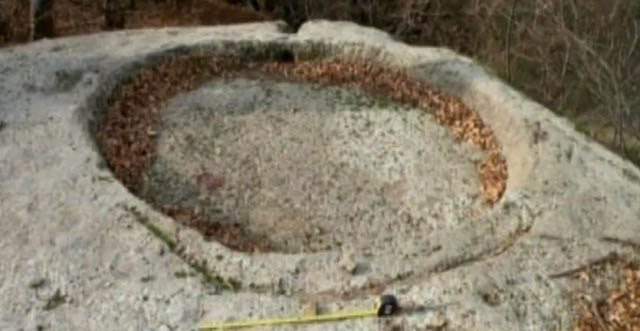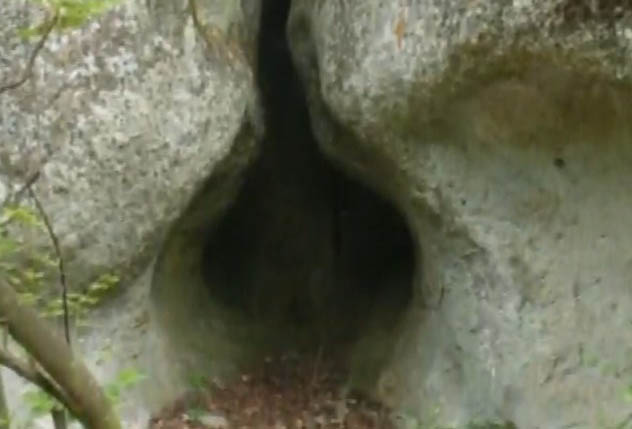It looks like you're using an Ad Blocker.
Please white-list or disable AboveTopSecret.com in your ad-blocking tool.
Thank you.
Some features of ATS will be disabled while you continue to use an ad-blocker.
share:
This is interesting, a five stepped megalithic pyramid dated back 4,500 years in Bulgaria;
Thracian Rock Step Pyramid
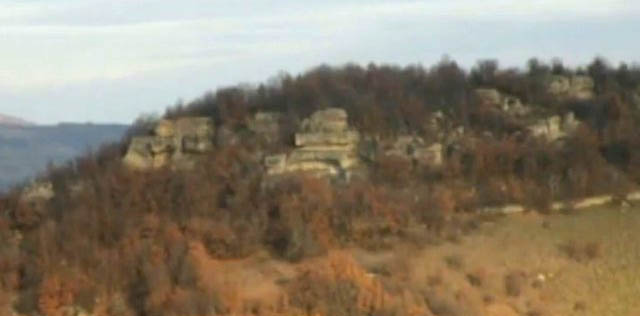
There are all sorts of features associated with the complex, a womb like cave created within it, and the carving into the rock of pooled enclosures perhaps used for sacred brew in connection to whatever rituals were performed there.
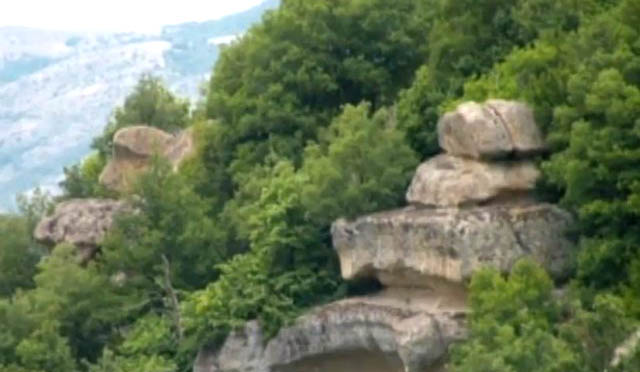
They seem to have taken advantage of the existing mount and re-arranged the megalithic boulders in the vicinity to create the complex.
It would be very interesting if they could push back interest in such structures in the Balkans a little further as there is some suggestion of connection between cultures from that region and the establishment of Uruk in connection to early scripts, and of course their interest in stepped monuments, earlier Vinca culture appears to have had an interest in pyramid form.
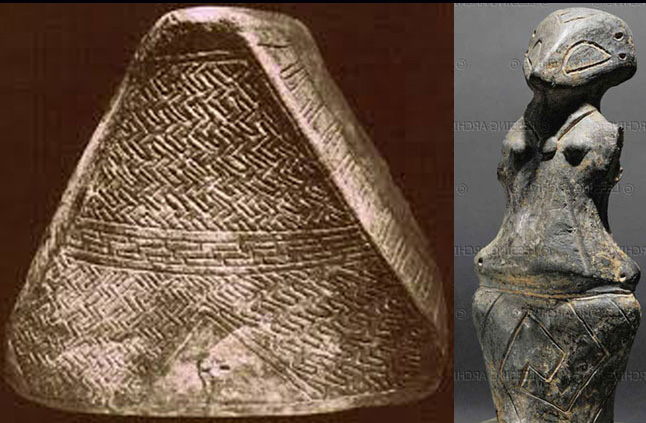
In some ways what is suggested here reminds me of similar structures claimed by some as pyramids in areas such as the Urals, which are covered in this video.
Thracian Rock Step Pyramid
An Ancient Thracian rock step pyramid with a rock sun temple dating back to 2500 BC has been identified in the Eastern Rhodope Mountains in Southern Bulgaria by an expedition of historians and thracologists.
It is about 15 meters tall, and consists of five stepped terraces, with the sun temple hacked into the rocks inside it, according to Prof. Vasil Markov, a historian specializing in the civilization of Ancient Thrace.

There are all sorts of features associated with the complex, a womb like cave created within it, and the carving into the rock of pooled enclosures perhaps used for sacred brew in connection to whatever rituals were performed there.
“We have come back with really interesting results which, to be honest, have surprised even me, especially with respect to the dating and the features of these monuments,
These are a type of pyramids. In science, they are also known as terraced sacrificial altars or pyramid-like structures. But the one that we found near the town of Kovil in the Eastern Rhodopes is a pyramid all the way. It is a terraced step pyramid towering at 15 meters, with five levels, with a sun temple hacked [into the rock] inside it,”

They seem to have taken advantage of the existing mount and re-arranged the megalithic boulders in the vicinity to create the complex.
In his words, the Ancient Thracian pyramid was itself hacked into the rocks of a large plateau, and was the center of a large territory considered to have been sacred by the Thracians.
It contains lots of sacrificial altars, “vessels” hacked into the “holy rocks” for the making of “holy wine”, and other megalithic structures.
The Womb Cave near Ilinitsa, which was apparently worshiped by the Ancient Thracians, consists of a natural vertical crack in the rocks leading into a cave whose entrance was shaped artificially to resemble a woman’s womb. Inside the cave, there is an altar.
The sunlight reaches the bottom of the cave only at a certain part of the day resembling a solar phallus which was seen by the ancient people as symbolizing the copulation and holy marriage of the Sun and the Mountain (i.e. the Earth).
According to Markov, the newly identified Thracian step pyramid contains an identical womb cave that is just smaller. He notes that when viewed from the inside the sunlight resembles a phallus copulating with the cave as part of the above-mentioned “holy marriage”, according to the Thracians’ beliefs.
It would be very interesting if they could push back interest in such structures in the Balkans a little further as there is some suggestion of connection between cultures from that region and the establishment of Uruk in connection to early scripts, and of course their interest in stepped monuments, earlier Vinca culture appears to have had an interest in pyramid form.

In some ways what is suggested here reminds me of similar structures claimed by some as pyramids in areas such as the Urals, which are covered in this video.
edit on Kam1231355vAmerica/ChicagoTuesday2231 by Kantzveldt because: (no reason given)
edit on
Kam1231355vAmerica/ChicagoTuesday2231 by Kantzveldt because: (no reason given)
a reply to: Kantzveldt
Thanks for the post . I am 1/2 hour into the doc and am hoping for some clever observation I could share .At this point it seems that any and all crazy suggestions might be worth considering because the standard PHD text books on such subjects misses the greater evidence that could suggest they are dead wrong .
The destruction of some is cruel .Some understandable .The hiding of the others and the lack of investigation into them brings up the bigger question as to why . Are they hiding something they don't want us to know about our past . To think the ancients didn't know about each other does not fit the similar methods and possible dates these things share . Are the ones in the oceans older or younger then the ones we have on land ?
Why such large stones for small structures ? cutting and moving large stones didn't seem to pose a problem so why small stones in some ? Why steps and why not steps ? They say that if you build it they will come .Who were the they and where did they come from ? Who built the darn things and why ? thanks again op S&F
Thanks for the post . I am 1/2 hour into the doc and am hoping for some clever observation I could share .At this point it seems that any and all crazy suggestions might be worth considering because the standard PHD text books on such subjects misses the greater evidence that could suggest they are dead wrong .
The destruction of some is cruel .Some understandable .The hiding of the others and the lack of investigation into them brings up the bigger question as to why . Are they hiding something they don't want us to know about our past . To think the ancients didn't know about each other does not fit the similar methods and possible dates these things share . Are the ones in the oceans older or younger then the ones we have on land ?
Why such large stones for small structures ? cutting and moving large stones didn't seem to pose a problem so why small stones in some ? Why steps and why not steps ? They say that if you build it they will come .Who were the they and where did they come from ? Who built the darn things and why ? thanks again op S&F
a reply to: Kantzveldt
This is really interesting, but I would agree with the alternative description as these being altars, or "pyramid-like structures" more than actually being megalithic step pyramids.
But regardless of the semantics, It's a pretty cool site that deserves some in-depth study, for sure.
This is really interesting, but I would agree with the alternative description as these being altars, or "pyramid-like structures" more than actually being megalithic step pyramids.
But regardless of the semantics, It's a pretty cool site that deserves some in-depth study, for sure.
a reply to: the2ofusr1
Yes it's around the 1.10 minute mark she looks at the Ural mountain structures which don't really get any recognition but remind me of what has been identified in Bulgaria, she does also cover them here;
The site in Bulgaria nobody else is yet reporting, but i think it's interesting that these sites show evidence of working with the natural formations and geological structures, but also adapt them, that the places themselves have natural symbolic associations and the part of those who constructed there to recognize these and work with them.
a reply to: SlapMonkey
There are other examples of the creation of sacred platform sites in that region, but in this case they are talking pyramid which of course will get more attention.
Yes it's around the 1.10 minute mark she looks at the Ural mountain structures which don't really get any recognition but remind me of what has been identified in Bulgaria, she does also cover them here;
The site in Bulgaria nobody else is yet reporting, but i think it's interesting that these sites show evidence of working with the natural formations and geological structures, but also adapt them, that the places themselves have natural symbolic associations and the part of those who constructed there to recognize these and work with them.
a reply to: SlapMonkey
There are other examples of the creation of sacred platform sites in that region, but in this case they are talking pyramid which of course will get more attention.
These are a type of pyramids. In science, they are also known as terraced sacrificial altars or pyramid-like structures. But the one that we found near the town of Kovil in the Eastern Rhodopes is a pyramid all the way. It is a terraced step pyramid towering at 15 meters, with five levels
edit on Kam1231355vAmerica/ChicagoTuesday2231 by Kantzveldt because: (no reason given)
edit on
Kam1231355vAmerica/ChicagoTuesday2231 by Kantzveldt because: (no reason given)
Newearth is a wonderful channel. I love how she doccuments everything so you can look for yourself and make your own conclussions.
This is very interesting. The past we don't understand or have documentary is the most interesting to me.
This is very interesting. The past we don't understand or have documentary is the most interesting to me.
a reply to: Kantzveldt
The TIME question is one of the bigger factors in establishing the history . Todays PHD time scales might be missing the larger explanation to determine a time . We know about the Ice Age and can date it pretty close and so that gives us one reference point . The other point which might give a clue to why the Ice Age and why we see things out of the timing is the Flood ... There is yet another point recorded in older cultures that make mention if the Long Day or Long Night depending on where it was recorded and it was recorded and does not contradict the Night/Day timing .
I was a bit undecided but finally decided to post this vid .It does have more biblical quotes then many might care to listen to but it does address the past with clips of other evidences that might be a dot to help connect to the rest .
The TIME question is one of the bigger factors in establishing the history . Todays PHD time scales might be missing the larger explanation to determine a time . We know about the Ice Age and can date it pretty close and so that gives us one reference point . The other point which might give a clue to why the Ice Age and why we see things out of the timing is the Flood ... There is yet another point recorded in older cultures that make mention if the Long Day or Long Night depending on where it was recorded and it was recorded and does not contradict the Night/Day timing .
I was a bit undecided but finally decided to post this vid .It does have more biblical quotes then many might care to listen to but it does address the past with clips of other evidences that might be a dot to help connect to the rest .
edit on 22-12-2015 by the2ofusr1 because: (no reason given)
edit on 22-12-2015 by the2ofusr1 because: (no reason
given)
This Joshuas long day might be another point for dating edit on 22-12-2015 by the2ofusr1 because:
(no reason given)
a reply to: the2ofusr1
Good post and video... Could also have something to do with other cities like Atlantis being sunk.
Good post and video... Could also have something to do with other cities like Atlantis being sunk.
a reply to: Iamthatbish
It is, i always enjoy her honest enquiry and presentations, it helps she is Russian to make the case for sites in the Urals because there is very little information on them.
a reply to: the2ofusr1
The time question on many sites remains uncertain, particularly those which were later reworked and utilized as seems to often be the case in Incan sites in my opinion. I think what can be said is that many of the basics of say Sumerian and Egyptian religion and sacred architecture date back to the megalithic sites, in that all the elements of the sacred mountain, the chamber within the Earth for the light to enter into and emerge from, the concept of life force represented in the sacred beverage, can be found at the Bulgarian site, even though it is suggested as contemporary to them in this case.
It is, i always enjoy her honest enquiry and presentations, it helps she is Russian to make the case for sites in the Urals because there is very little information on them.
a reply to: the2ofusr1
The time question on many sites remains uncertain, particularly those which were later reworked and utilized as seems to often be the case in Incan sites in my opinion. I think what can be said is that many of the basics of say Sumerian and Egyptian religion and sacred architecture date back to the megalithic sites, in that all the elements of the sacred mountain, the chamber within the Earth for the light to enter into and emerge from, the concept of life force represented in the sacred beverage, can be found at the Bulgarian site, even though it is suggested as contemporary to them in this case.
edit on Kam1231355vAmerica/ChicagoTuesday2231 by Kantzveldt because: (no reason given)
a reply to: Kantzveldt
Growing up I discovered this mound in the middle of the woods that the locals called the Bores Back . There are trees growing on it but I often wondered to myself if a person was to dig ,would they find something ? It is a very out of place mound ...It would be fun to work on something like that ..
Growing up I discovered this mound in the middle of the woods that the locals called the Bores Back . There are trees growing on it but I often wondered to myself if a person was to dig ,would they find something ? It is a very out of place mound ...It would be fun to work on something like that ..
the only explanation I can give about the Sferes from transfaal found in embedded rock 2.8 billionyears old =
Oure solar system is build from debris from an nova/supernova
if that exploded star had planets with intelligent live than they would be scatterd in big and micro debris..
not impossibel that such debris holds artifacts and formed the later solarsystem as we now know..
the sfeers could have survived (by there form) and feld later to earth...
anothe thinking.... if an nova explodes the remains of the star its-self forms an white dwarf..
the nearest white dwarf is Sirius B .......
perhaps she was the mother of oure sun?
the egypts loved Sirius ! a reply to: the2ofusr1
Oure solar system is build from debris from an nova/supernova
if that exploded star had planets with intelligent live than they would be scatterd in big and micro debris..
not impossibel that such debris holds artifacts and formed the later solarsystem as we now know..
the sfeers could have survived (by there form) and feld later to earth...
anothe thinking.... if an nova explodes the remains of the star its-self forms an white dwarf..
the nearest white dwarf is Sirius B .......
perhaps she was the mother of oure sun?
the egypts loved Sirius ! a reply to: the2ofusr1
originally posted by: the2ofusr1
a reply to: Kantzveldt
Growing up I discovered this mound in the middle of the woods that the locals called the Bores Back . There are trees growing on it but I often wondered to myself if a person was to dig ,would they find something ? It is a very out of place mound ...It would be fun to work on something like that ..
Are you in New Brunswick? You might want to check out the laws before digging...
Link
a reply to: Kantzveldt
Very nice find. Looking from a distance, I would have assumed it was a very cool natural formation, but it seems there is more than enough evidence to confirm this was built. Now would this lend any evidence or help prove the Bosnian Pyramid theory I wonder? Not exactly next door, but somewhat in the vicinity.
Very nice find. Looking from a distance, I would have assumed it was a very cool natural formation, but it seems there is more than enough evidence to confirm this was built. Now would this lend any evidence or help prove the Bosnian Pyramid theory I wonder? Not exactly next door, but somewhat in the vicinity.
a reply to: Rexamus
Perhaps it will give those who believe in the Bosnian pyramids encouragement but i don't think it will really help their case, very interesting with regards to the origins of the cult of Dionysous in Thracia though.
a reply to: the2ofusr1
Of course it depends where the mounds are and from what period as to what you might expect to find inside, sometimes maybe cremation remains in an urn, if the Crimea maybe a skeleton and lots of gold, these things were culture specific.
Perhaps it will give those who believe in the Bosnian pyramids encouragement but i don't think it will really help their case, very interesting with regards to the origins of the cult of Dionysous in Thracia though.
a reply to: the2ofusr1
Of course it depends where the mounds are and from what period as to what you might expect to find inside, sometimes maybe cremation remains in an urn, if the Crimea maybe a skeleton and lots of gold, these things were culture specific.
edit on Kpm1231355vAmerica/ChicagoTuesday2231 by Kantzveldt because: (no reason given)
a reply to: JohnnyCanuck
Thanks for the link . I read the act but I wonder if First Nations may have a parallel program of if they fall under the same regulations and restrictions ?
Thanks for the link . I read the act but I wonder if First Nations may have a parallel program of if they fall under the same regulations and restrictions ?
a reply to: Kantzveldt
Its really hard to say how deep and what is under this thing or if anything is there at all . Göbekli Tepe comes to mind in one sense as that was hidden in plain sight for so long . Its more of a feeling I have about the site as it resembles nothing like it in the surrounding areas .
Of course it depends where the mounds are and from what period as to what you might expect to find inside, sometimes maybe cremation remains in an urn, if the Crimea maybe a skeleton and lots of gold, these things were culture specific.
It appears to be a natural formation. We don't see signs of humans building it (such as discontinuity in the rock layers).
In addition, Thrace (as a country or a culture group) did not exist until the Roman times (around 500 BC) and therefore it could not have been built by Thracians: en.wikipedia.org...
Since Thracian technology would have been concurrent with Roman technology, they would have used small blocks of stone (the world had gone to less labor-intensive sized blocks by then) and would have used Roman construction techniques.
And (as someone else said) it really doesn't look much like a pyramid. It looks like a limestone outcrop. They are claiming that it was a modified hill, but there's little evidence of human modification.
In addition, Thrace (as a country or a culture group) did not exist until the Roman times (around 500 BC) and therefore it could not have been built by Thracians: en.wikipedia.org...
Since Thracian technology would have been concurrent with Roman technology, they would have used small blocks of stone (the world had gone to less labor-intensive sized blocks by then) and would have used Roman construction techniques.
And (as someone else said) it really doesn't look much like a pyramid. It looks like a limestone outcrop. They are claiming that it was a modified hill, but there's little evidence of human modification.
originally posted by: the2ofusr1
a reply to: JohnnyCanuck
Thanks for the link . I read the act but I wonder if First Nations may have a parallel program of if they fall under the same regulations and restrictions ?
They do. You will have to ask them.
originally posted by: the2ofusr1
a reply to: JohnnyCanuck
Thanks for the link . I read the act but I wonder if First Nations may have a parallel program of if they fall under the same regulations and restrictions ?
I know that in Ontario, we have been putting a great deal of emphasis on consultation and inclusion with the First Nations, with regards to archaeology. If your mound is man-made, it may well hold Ancestors. You'd want it examined in a knowledgeable manner. Riffing off of Byrd, here, check out the New Brunswick Archaeological Society. They can answer questions, and such groups have been known to directly assist members of the FN in learning both technique and legal process. Let us know how it works out, if you follow it up..
It all kind of comes full circle in this thread, in terms of a disciplined approach to getting a site to give up its secrets. They say it's a pyramid? There will be signs if it is man-made, but you won't want to go in breaking stuff in the search for 'goodies'.
On the other hand, as I have written in a different forum...sometimes it's just a rock.
edit on 22-12-2015 by JohnnyCanuck because:
yes!
a reply to: Byrd
Of course it can only be considered as in the geographic region of Thracia, and not Thracian as such, but i don't think you can say from the images which were only screen grabs from a Bulgarian news report that doesn't seem to be available yet, whether that is overall a five step megalithic construction or not, so you are left with the case that will need to be made by the team making the claim, who do appear to have the academic credentials to make such.
Of course it can only be considered as in the geographic region of Thracia, and not Thracian as such, but i don't think you can say from the images which were only screen grabs from a Bulgarian news report that doesn't seem to be available yet, whether that is overall a five step megalithic construction or not, so you are left with the case that will need to be made by the team making the claim, who do appear to have the academic credentials to make such.
a reply to: Byrd
Thanks . I cant see me doing any digging but I might let First Nations know about the spot . Its about 200 yards away from a Native trail that has a hwy there now . The Romans used very large stone construction .This vid goes into it a bit but the motive was to debunk ancient aliens ....
Thanks . I cant see me doing any digging but I might let First Nations know about the spot . Its about 200 yards away from a Native trail that has a hwy there now . The Romans used very large stone construction .This vid goes into it a bit but the motive was to debunk ancient aliens ....
new topics
-
What Comes After January 20th
Mainstream News: 34 minutes ago -
Canada as a state .. how would it work?
General Chit Chat: 43 minutes ago -
Those stupid GRAVITE commercials
Rant: 1 hours ago -
Let's Buy Greenland
General Chit Chat: 2 hours ago -
Planned Civil War In Britain May Be Triggered Soon
Social Issues and Civil Unrest: 5 hours ago -
Claim: General Mark Milley Approved Heat and Sound Directed Energy Weapons During 2020 Riots
Whistle Blowers and Leaked Documents: 6 hours ago
top topics
-
Claim: General Mark Milley Approved Heat and Sound Directed Energy Weapons During 2020 Riots
Whistle Blowers and Leaked Documents: 6 hours ago, 11 flags -
Planned Civil War In Britain May Be Triggered Soon
Social Issues and Civil Unrest: 5 hours ago, 5 flags -
Let's Buy Greenland
General Chit Chat: 2 hours ago, 4 flags -
What Comes After January 20th
Mainstream News: 34 minutes ago, 4 flags -
Those stupid GRAVITE commercials
Rant: 1 hours ago, 2 flags -
Canada as a state .. how would it work?
General Chit Chat: 43 minutes ago, 0 flags
active topics
-
What Comes After January 20th
Mainstream News • 4 • : JadedGhost -
Let's Buy Greenland
General Chit Chat • 11 • : CarlLaFong -
Those stupid GRAVITE commercials
Rant • 3 • : Cre8chaos79 -
Canada as a state .. how would it work?
General Chit Chat • 5 • : CriticalStinker -
Gravitic Propulsion--What IF the US and China Really Have it?
General Conspiracies • 30 • : Lazy88 -
Remember These Attacks When President Trump 2.0 Retribution-Justice Commences.
2024 Elections • 133 • : Oldcarpy2 -
Sorry to disappoint you but...
US Political Madness • 40 • : cherokeetroy -
January 6th report shows disturbing trend (nobody is shocked)
US Political Madness • 72 • : JadedGhost -
-@TH3WH17ERABB17- -Q- ---TIME TO SHOW THE WORLD--- -Part- --44--
Dissecting Disinformation • 3954 • : Thoughtful3 -
Claim: General Mark Milley Approved Heat and Sound Directed Energy Weapons During 2020 Riots
Whistle Blowers and Leaked Documents • 20 • : NoCorruptionAllowed

